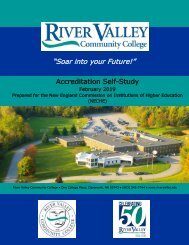You also want an ePaper? Increase the reach of your titles
YUMPU automatically turns print PDFs into web optimized ePapers that Google loves.
Cash and cash equivalents in the statement of cash flows include unrestricted cash which is either<br />
held in demand deposit or short-term money market accounts, and highly-liquid savings deposits<br />
and investments with original maturities of three months or less when purchased.<br />
Student Loans Receivable<br />
The Federal Perkins Student Loan Program has provisions for deferment, forbearance, and<br />
cancellation of the individual loans. Principal payments, interest, and losses due to cancellation are<br />
shared by the College and the U.S. Government in proportion to their share of funds provided.<br />
Such funds may be reloaned by CCSNH after collection. Amounts advanced by the federal<br />
government under this program are ultimately refundable and are classified as refundable<br />
advances.<br />
Student loans receivable are stated at their unpaid principal balances adjusted for charge-offs and<br />
the allowance for loan losses. Interest income on student loans receivable is recorded when<br />
received. CCSNH provides for probable uncollectible amounts through a charge to expense and a<br />
credit to the allowance for loan losses based on its assessment of the current status of individual<br />
accounts. Balances that are still outstanding after the College has used reasonable collection<br />
efforts are written off through a charge to the allowance for loan losses and a credit to student<br />
loans receivable. Student loans receivable at June 30, 2018 and 2017 net of an allowance for loan<br />
losses was $524,473.<br />
Collections of the student loans receivable may not be used to pay current liabilities, as the<br />
proceeds are restricted for making new loans. Accordingly, the student loans receivable are<br />
recorded in the accompanying statements of net position as noncurrent assets.<br />
Investments<br />
CCSNH and the Foundation carry investments at their fair value. Fair value is estimated using the<br />
methods described in Note 10. Purchased and gifted securities are recorded at fair value on the<br />
date of the acquisition or gift, net of any brokerage fees. Realized and unrealized gains and losses<br />
in the investment portfolio are allocated on a specific-identification basis.<br />
Capital Assets<br />
Capital assets are recorded at cost when purchased or constructed and at fair value at the date of<br />
donation. In accordance with CCSNH's capitalization policy, only equipment (including equipment<br />
acquired under capital leases), capital projects and internally-generated intangibles with a<br />
projected cost of $5,000 or more are capitalized. Costs for maintenance, repairs and minor<br />
renewals and replacements are expensed as incurred. The costs of library materials are expensed<br />
as incurred.<br />
Depreciation and amortization of assets acquired are recorded on a straight-line basis over the<br />
estimated useful lives of the related assets, principally as follows:<br />
Buildings<br />
Building and land improvements<br />
Equipment and vehicles<br />
40 years<br />
20 years<br />
5 years<br />
227 | P a g e





